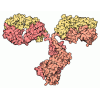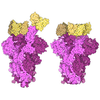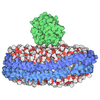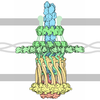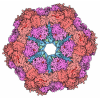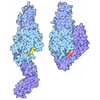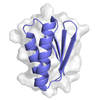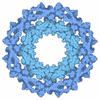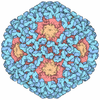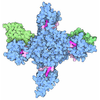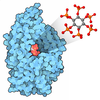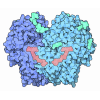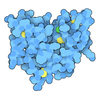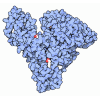+ Open data
Open data
- Basic information
Basic information
| Entry | Database: PDB / ID: 9bdt | ||||||||||||||||||||||||
|---|---|---|---|---|---|---|---|---|---|---|---|---|---|---|---|---|---|---|---|---|---|---|---|---|---|
| Title | Apolipoprotein B 100 bound to LDL receptor and legobody | ||||||||||||||||||||||||
 Components Components |
| ||||||||||||||||||||||||
 Keywords Keywords | LIPID TRANSPORT / LDL / ApoB100 / LDL receptor | ||||||||||||||||||||||||
| Function / homology |  Function and homology information Function and homology informationmature chylomicron / Scavenging by Class H Receptors / triglyceride mobilization / positive regulation of cholesterol storage / VLDL assembly / regulation of cholesterol biosynthetic process / receptor-mediated endocytosis involved in cholesterol transport / regulation of phosphatidylcholine catabolic process / lipase binding / plasma lipoprotein particle clearance ...mature chylomicron / Scavenging by Class H Receptors / triglyceride mobilization / positive regulation of cholesterol storage / VLDL assembly / regulation of cholesterol biosynthetic process / receptor-mediated endocytosis involved in cholesterol transport / regulation of phosphatidylcholine catabolic process / lipase binding / plasma lipoprotein particle clearance / LDL remodeling / Scavenging by Class B Receptors / positive regulation of lysosomal protein catabolic process / negative regulation of astrocyte activation / VLDL clearance / negative regulation of microglial cell activation / triglyceride catabolic process / very-low-density lipoprotein particle assembly / very-low-density lipoprotein particle receptor activity / PCSK9-LDLR complex / cholesterol import / low-density lipoprotein particle clearance / clathrin heavy chain binding / negative regulation of receptor recycling / positive regulation of triglyceride biosynthetic process / intestinal cholesterol absorption / negative regulation of low-density lipoprotein particle clearance / chylomicron remnant / intermediate-density lipoprotein particle / low-density lipoprotein particle receptor activity / response to caloric restriction / Chylomicron clearance / low-density lipoprotein particle binding / amyloid-beta clearance by cellular catabolic process / Chylomicron remodeling / cellular response to lipoprotein particle stimulus / Chylomicron assembly / LDL clearance / positive regulation of lipid storage / flagellated sperm motility / Regulation of TLR by endogenous ligand / high-density lipoprotein particle clearance / chylomicron / regulation of protein metabolic process / lipoprotein catabolic process / phospholipid transport / low-density lipoprotein particle / lipoprotein biosynthetic process / cholesterol transfer activity / cholesterol transport / very-low-density lipoprotein particle / low-density lipoprotein particle remodeling / endolysosome membrane / positive regulation of macrophage derived foam cell differentiation / negative regulation of amyloid fibril formation / fertilization / IgG binding / cholesterol efflux / regulation of cholesterol metabolic process / negative regulation of protein metabolic process / artery morphogenesis / lipoprotein transport / Scavenging by Class A Receptors / cellular response to fatty acid / low-density lipoprotein particle receptor binding / Scavenging by Class F Receptors / Platelet sensitization by LDL / sorting endosome / amyloid-beta clearance / endoplasmic reticulum exit site / lipoprotein particle binding / cellular response to low-density lipoprotein particle stimulus / long-term memory / carbohydrate transmembrane transporter activity / maltose binding / maltose transport / maltodextrin transmembrane transport / phagocytosis / smooth endoplasmic reticulum / retinoid metabolic process / Retinoid metabolism and transport / ATP-binding cassette (ABC) transporter complex, substrate-binding subunit-containing / clathrin-coated pit / somatodendritic compartment / lipid droplet / endocytic vesicle lumen / receptor-mediated endocytosis / cholesterol metabolic process / lysosomal lumen / cholesterol homeostasis / endosome lumen / post-embryonic development / Cell surface interactions at the vascular wall / establishment of localization in cell / Post-translational protein phosphorylation / clathrin-coated endocytic vesicle membrane / Heme signaling / response to virus / phospholipid binding / lipid metabolic process Similarity search - Function | ||||||||||||||||||||||||
| Biological species |     Homo sapiens (human) Homo sapiens (human) | ||||||||||||||||||||||||
| Method | ELECTRON MICROSCOPY / single particle reconstruction / cryo EM / Resolution: 5.4 Å | ||||||||||||||||||||||||
 Authors Authors | Dearborn, A.D. / Reimund, M. / Graziano, G. / Lei, H. / Kumar, A. / Neufeld, E.B. / Remaley, A.T. / Marcotrigiano, J. | ||||||||||||||||||||||||
| Funding support |  United States, 1items United States, 1items
| ||||||||||||||||||||||||
 Citation Citation |  Journal: Nature / Year: 2025 Journal: Nature / Year: 2025Title: Structure of apolipoprotein B100 bound to the low-density lipoprotein receptor. Authors: Mart Reimund / Altaira D Dearborn / Giorgio Graziano / Haotian Lei / Anthony M Ciancone / Ashish Kumar / Ronald Holewinski / Edward B Neufeld / Francis J O'Reilly / Alan T Remaley / Joseph Marcotrigiano /  Abstract: Apolipoprotein B100 (apoB100) is a structural component of low-density lipoprotein (LDL) and a ligand for the LDL receptor (LDLR). Mutations in apoB100 or in LDLR cause familial ...Apolipoprotein B100 (apoB100) is a structural component of low-density lipoprotein (LDL) and a ligand for the LDL receptor (LDLR). Mutations in apoB100 or in LDLR cause familial hypercholesterolaemia, an autosomal dominant disease that is characterized by a marked increase in LDL cholesterol (LDL-C) and a higher risk of cardiovascular disease. The structure of apoB100 on LDL and its interaction with LDLR are poorly understood. Here we present the cryo-electron microscopy structures of apoB100 on LDL bound to the LDLR and a nanobody complex, which can form a C-symmetric, higher-order complex. Using local refinement, we determined high-resolution structures of the interfaces between apoB100 and LDLR. One binding interface is formed between several small-ligand-binding modules of LDLR and a series of basic patches that are scattered along a β-belt formed by apoB100, encircling LDL. The other binding interface is formed between the β-propeller domain of LDLR and the N-terminal domain of apoB100. Our results reveal how both interfaces are involved in LDL dimer formation, and how LDLR cycles between LDL- and self-bound conformations. In addition, known mutations in either apoB100 or LDLR, associated with high levels of LDL-C, are located at the LDL-LDLR interface. | ||||||||||||||||||||||||
| History |
|
- Structure visualization
Structure visualization
| Structure viewer | Molecule:  Molmil Molmil Jmol/JSmol Jmol/JSmol |
|---|
- Downloads & links
Downloads & links
- Download
Download
| PDBx/mmCIF format |  9bdt.cif.gz 9bdt.cif.gz | 922.9 KB | Display |  PDBx/mmCIF format PDBx/mmCIF format |
|---|---|---|---|---|
| PDB format |  pdb9bdt.ent.gz pdb9bdt.ent.gz | Display |  PDB format PDB format | |
| PDBx/mmJSON format |  9bdt.json.gz 9bdt.json.gz | Tree view |  PDBx/mmJSON format PDBx/mmJSON format | |
| Others |  Other downloads Other downloads |
-Validation report
| Summary document |  9bdt_validation.pdf.gz 9bdt_validation.pdf.gz | 1.3 MB | Display |  wwPDB validaton report wwPDB validaton report |
|---|---|---|---|---|
| Full document |  9bdt_full_validation.pdf.gz 9bdt_full_validation.pdf.gz | 1.5 MB | Display | |
| Data in XML |  9bdt_validation.xml.gz 9bdt_validation.xml.gz | 165.3 KB | Display | |
| Data in CIF |  9bdt_validation.cif.gz 9bdt_validation.cif.gz | 245.5 KB | Display | |
| Arichive directory |  https://data.pdbj.org/pub/pdb/validation_reports/bd/9bdt https://data.pdbj.org/pub/pdb/validation_reports/bd/9bdt ftp://data.pdbj.org/pub/pdb/validation_reports/bd/9bdt ftp://data.pdbj.org/pub/pdb/validation_reports/bd/9bdt | HTTPS FTP |
-Related structure data
| Related structure data | 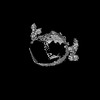 44469MC 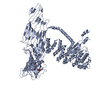 9bd1C 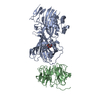 9bd8C 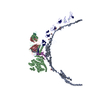 9bdeC 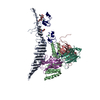 9cooC M: map data used to model this data C: citing same article ( |
|---|---|
| Similar structure data | Similarity search - Function & homology  F&H Search F&H Search |
- Links
Links
- Assembly
Assembly
| Deposited unit | 
|
|---|---|
| 1 |
|
- Components
Components
-Protein , 2 types, 3 molecules AIR
| #1: Protein | Mass: 516167.469 Da / Num. of mol.: 1 / Source method: isolated from a natural source / Source: (natural)  Homo sapiens (human) / References: UniProt: P04114 Homo sapiens (human) / References: UniProt: P04114 |
|---|---|
| #5: Protein | Mass: 95477.023 Da / Num. of mol.: 2 Source method: isolated from a genetically manipulated source Source: (gene. exp.)  Homo sapiens (human) / Gene: LDLR / Production host: Homo sapiens (human) / Gene: LDLR / Production host:  Homo sapiens (human) / References: UniProt: P01130 Homo sapiens (human) / References: UniProt: P01130 |
-Antibody , 4 types, 4 molecules HLBN
| #2: Antibody | Mass: 25252.217 Da / Num. of mol.: 1 Source method: isolated from a genetically manipulated source Source: (gene. exp.)   |
|---|---|
| #3: Antibody | Mass: 24095.852 Da / Num. of mol.: 1 Source method: isolated from a genetically manipulated source Source: (gene. exp.)   Homo sapiens (human) Homo sapiens (human) |
| #4: Antibody | Mass: 59233.246 Da / Num. of mol.: 1 Source method: isolated from a genetically manipulated source Source: (gene. exp.)   Gene: malE, malE_1, A9X72_23600, ACN81_05700, ACU57_23670, AM464_13530, B6R31_000964, BANRA_05111, BCB93_001091, BF481_003801, BG944_002391, BGM66_004246, BJI68_06200, BJJ90_24825, BK292_00970, BTB68_ ...Gene: malE, malE_1, A9X72_23600, ACN81_05700, ACU57_23670, AM464_13530, B6R31_000964, BANRA_05111, BCB93_001091, BF481_003801, BG944_002391, BGM66_004246, BJI68_06200, BJJ90_24825, BK292_00970, BTB68_002078, BTQ06_17300, BvCmsKKP061_03224, BvCmsSIP010_04050, C0P57_003867, C1Q91_002164, C2R31_001890, C3F40_15210, C9E67_28370, CA593_05740, CF22_001770, CG692_11710, CG704_16590, CG831_003746, CIG67_12040, CQ986_003892, CR538_23895, CR539_01985, CTR35_003815, CV83915_02005, D4M65_12865, DIV22_28370, DNX30_07695, DS732_01860, DTL43_19585, E4K51_08355, E5H86_20640, E6D34_15030, EAI46_20350, EC95NR1_03574, ECs5017, EIZ93_13775, EN85_000970, EPS97_17355, ExPECSC038_04540, F9407_08085, F9461_21760, FIJ20_18085, FJQ40_13885, FOI11_015465, FOI11_20215, FPS11_04610, FV293_00135, FWK02_22115, G3V95_18070, G4A38_02205, G4A47_04495, G9448_13225, GAI89_05080, GAJ12_13200, GJ11_25475, GKF66_19285, GNW61_17855, GOP25_18965, GP965_07770, GP975_07695, GP979_10140, GQA06_09595, GQM04_22095, GQM21_08325, GRW05_14255, GRW24_12940, GRW56_08975, GRW57_10345, GUC01_08260, H0O72_20100, HEP30_015080, HHH44_003952, HLX92_13085, HMV95_14740, HV109_22180, HV209_20940, HVW43_14700, HVY77_23840, HX086_10250, HX136_23390, I6H00_16895, I6H02_15990, J0541_001933, J5U05_001620, JNP96_01525, KV259_002584, KV317_002918, KV371_002846, KV406_003109, KV449_002737, KV455_002759, KV463_002918, KV469_002607, KV499_002898, KV500_002927, NCTC10418_07064, NCTC10429_00012, NCTC10865_05806, NCTC11126_02082, NCTC11181_01902, NCTC12950_05149, NCTC13148_04480, NCTC4450_01671, NCTC8009_08341, NCTC8179_05034, NCTC8333_05503, NCTC8500_05253, NCTC8622_01707, NCTC8960_02276, NCTC8985_03950, NCTC9706_01951, NCTC9962_03706, NEP60_16880, O5851_07355, RG28_25590, SAMEA3752557_02201, TUM18780_41180, WR15_07725, spa, SA0107, spg Production host:  References: UniProt: C3SHQ8, UniProt: P99134, UniProt: P06654 |
| #6: Antibody | Mass: 14322.896 Da / Num. of mol.: 1 Source method: isolated from a genetically manipulated source Source: (gene. exp.)   |
-Sugars , 2 types, 5 molecules 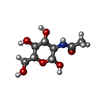
| #7: Polysaccharide | 2-acetamido-2-deoxy-beta-D-glucopyranose-(1-4)-2-acetamido-2-deoxy-beta-D-glucopyranose Source method: isolated from a genetically manipulated source |
|---|---|
| #8: Sugar | ChemComp-NAG / |
-Non-polymers , 1 types, 7 molecules 
| #9: Chemical | ChemComp-CA / |
|---|
-Details
| Has ligand of interest | N |
|---|---|
| Has protein modification | Y |
-Experimental details
-Experiment
| Experiment | Method: ELECTRON MICROSCOPY |
|---|---|
| EM experiment | Aggregation state: PARTICLE / 3D reconstruction method: single particle reconstruction |
- Sample preparation
Sample preparation
| Component | Name: Apoliprotein B 100 from LDL bound to LDL receptor and Legobody Type: COMPLEX / Entity ID: #2-#6 / Source: NATURAL |
|---|---|
| Molecular weight | Experimental value: NO |
| Source (natural) | Organism:  Homo sapiens (human) Homo sapiens (human) |
| Buffer solution | pH: 7.4 |
| Specimen | Embedding applied: NO / Shadowing applied: NO / Staining applied: NO / Vitrification applied: YES |
| Specimen support | Grid material: GOLD / Grid mesh size: 300 divisions/in. / Grid type: C-flat-1.2/1.3 |
| Vitrification | Instrument: FEI VITROBOT MARK IV / Cryogen name: ETHANE |
- Electron microscopy imaging
Electron microscopy imaging
| Experimental equipment |  Model: Titan Krios / Image courtesy: FEI Company |
|---|---|
| Microscopy | Model: FEI TITAN KRIOS |
| Electron gun | Electron source:  FIELD EMISSION GUN / Accelerating voltage: 300 kV / Illumination mode: FLOOD BEAM FIELD EMISSION GUN / Accelerating voltage: 300 kV / Illumination mode: FLOOD BEAM |
| Electron lens | Mode: BRIGHT FIELD / Nominal defocus max: 2000 nm / Nominal defocus min: 600 nm |
| Image recording | Electron dose: 51.38 e/Å2 / Film or detector model: GATAN K3 BIOCONTINUUM (6k x 4k) |
- Processing
Processing
| CTF correction | Type: PHASE FLIPPING AND AMPLITUDE CORRECTION | ||||||||||||||||||||||||
|---|---|---|---|---|---|---|---|---|---|---|---|---|---|---|---|---|---|---|---|---|---|---|---|---|---|
| Particle selection | Num. of particles selected: 3689076 / Details: Selected with Topaz | ||||||||||||||||||||||||
| 3D reconstruction | Resolution: 5.4 Å / Resolution method: FSC 0.143 CUT-OFF / Num. of particles: 527598 / Symmetry type: POINT | ||||||||||||||||||||||||
| Refine LS restraints |
|
 Movie
Movie Controller
Controller



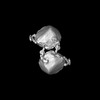
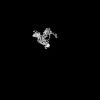



 PDBj
PDBj
